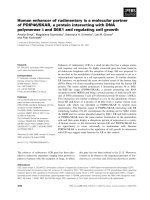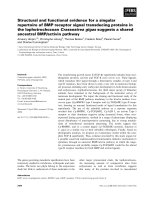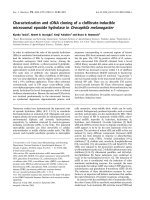Báo cáo khoa học: "Aspect and Discourse Structure: Is a Neutral Viewpoint Required?*" pot
Bạn đang xem bản rút gọn của tài liệu. Xem và tải ngay bản đầy đủ của tài liệu tại đây (249.83 KB, 3 trang )
Aspect and Discourse Structure:
Is a
Neutral
Viewpoint Required?*
Frank
Schilder
Centre for Cognitive Science
2 Buccleuch Place
Edinburgh EH8 9LW, Scotland, U.K.
Internet: schilder@cogsc±, ed. ac.uk
Abstract
We apply Smith's theory of aspect (1991)
to German - a language without any as-
pectual markers. In particular, we try
to shed more light on the effects aspect
can have on discourse structure and
show how English and German behave dif-
ferently in this respect. We furthermore
describe how Smith's notion of a neutral
viewpoint can be helpful for the anal-
ysis of discourse in German. It turned
out that proposals claiming that the Ger-
man Preterite covers the progressive as
well as the simple aspect can not suffi-
ciently explain the data presented in this
paper (B~iuerle, 1988). Finally we give
a sltuatlon-theoretic approach to for-
malize Smith's intuitions following Glas-
bey (1994) incorporating Allen's interval-
calculus (Allen, 1984).
1 Viewpoint and Situation Aspect
Smith (1991) presents two terms which are assigned
to two distinct phenomena in language: viewpoint
and situation aspect. This two-level theory gives
an explanation for the difference between aspectual
information understood as a view on a situation and
temporal features of a situation. The former can be
gained after applying a certain viewpoint chosen by
the speaker and the latter one is stored in the lexical
entry of a lexeme.l
" The author gratefully acknowledges the helpful
comments of Sheila Glasbey, Lex Holt and the three
anonymous reviewers of this paper. This research was
supported by a PhD-scholarship HSPII/AUFE awarded
by the German Academic Exchange Service (DAAD).
1Besides the situation aspect described by the seman-
tic entry of the verb many other sentential constituents
(e.g. object or subject NPs) may have an influence on it
(Krif~, 1992).
Situation Aspects
Smith introduces three so-
called "conceptual features" of situation aspects
which
have binary values [-4-], namely stative, dura-
tire and telic. Five different situation aspects have
emerged which are distinguished using these features
and certain temporal schemata? Examples:
- Sam owned three peach orchards. (State)
- Lily swam in the pond. (Activity)
- Mrs Ramsey wrote a letter. (Accomplishment)
- Lily knocked at the door. (Semelfactive)
- Mr Ramsey reached the lighthouse. (Achievement)
Viewpoints Smith postulates three different
viewpoints. Schematically she uses an idealised time
line where the initial and finishing points of a situ-
ation are indicated by I and F respectively. The
duration of the situation can be drawn in two differ-
ent ways: as an unstructured ( ) and a structured
( ) phase which has internal stages. The view-
point is understood in this representation as a focus
on parts or on the whole situation (///) (figure 1).
a) i IIIIIIIIIIIIIIII F
b)
I
F
IIIIIIIIIIIIIIII
c) I.
///
Figure 1: The a) imperfective b) perfective and c)
neutral viewpoint
Two viewpoints correspond mainly to the well-
known opposition perfective/imperfective. However,
additionally Smith assumes a so-called neutral view-
point which contains the initial point and at least
one internal stage.
Aspectually vague sentences which provide either
an open or a closed reading back up Smith's consid-
ZSee Smith (1991) for a detailed discussion.
326
erations (Smith, 1991:120). 3
However, she restricts her analysis to single sen-
tences and neglects the effects viewpoints can have
in a discourse. We will therefore focus on this issue
in the next section.
2 Discourse Structure
We investigate here which viewpoint is appropriate
for the German Preterite. B~uerle (1988:131), for
instance, claims that this tense in German is am-
biguous w.r.t, the perfective/imperfective view on a
situation and gives the following evidence for it:
(1) a. Der Angeklagte fuhr nach Hause. Dort
trank er ein Glas Trollinger.
The defendant drove home. There he
drank a glass of Trollinger.
b. Der Angeklagte fuhr nach Hause. Am
Lustnauer Tor hatte er einen schweren
Unfall und musste ins Krankenhaus
eingeliefert werden.
The defendant was driving home. At the
Lustnauer tower he had a serious accident
and had to be admitted to the hospital.
In (la) the VP fuhr nach Hause refers to a com-
pleted event and therefore contains an end point. In
(lb) this end point is denied by the second sentence.
Note that the English translation of (lb) is therefore
only correct if an imperfective view is used.
This data shows that the use of the Preterite in
German does not commit the speaker to saying any-
thing about the end point. Every inference regarding
the ending of a situation is due to the context or our
world knowledge.
It may be concluded from (1) that we cannot as-
sume a perfective viewpoint, because this view in-
cludes the end point of a situation. The follow-
ing discourse will furthermore show that also the
imperfective view is not applicable to the German
Preterite.
It is commonly supposed that the imperfective
viewpoint which refers to the middle of a situation
omitting the initial as well as the final point can be
used for describing a background within a discourse
(cf. Smith, 1991:130):
(2) The defendant had an accident. He was
driving home (at this time).
3FoUowing Smith (1991) we applied two tests to Ger-
man data regarding the temporal properties of the end
point of a situation which are discussed in Schilder
(1995).
A direct German translation, however, expresses two
subsequent events. At first the defendant had an
accident and then he drove home:
(3) Der Angeklagte hatte einen Unfall. Er fuhr
nach Hause (??zu der Zeit).
Adding the PP zu der Zeit ('at this time') the
sentence functions as a background for the event
described by the first sentence, but this discourse
sounds awkward and the continuation with a state
in (4) is clearly preferred. 4
(4) Er war auf dem Weg nach Hause.
Discourse (3) shows that for the German Preterite
the initial point is focussed by the viewpoint. This
observation proves therefore that this tense is not
ambiguous w.r.t the progressive and the simple as-
pect as B~uerle (1988) claims.
To sum up, these two discourses can be seen
to show that the German aspect system for the
Preterite offers only a neutral view on every situ-
ation.
Moreover, this data disproves B/~uerle's explana-
tion of (1), clarifies Smith's definition of a viewpoint
and motivates the need for a neutral viewpoint in
German.
It is obviously a shortcoming of Smith's descrip-
tion to define the viewpoint merely as a focus on
parts or on the whole situation. It emerged from
the discourse examples that a crucial function of the
viewpoint is the commitment the speaker gives as
to whether the end point has been reached or not.
In English, the perfective view sets the end point 5
and no cancellation is allowed afterwards. A neu-
tral view on a situation gives only a confirmation of
the initial point. It leaves open whether the end has
been reached or not. Only the temporal knowledge
derived from the situation aspect can provide further
information which, however, may be overridden by
the context.
3 A Situation-theoretic
Formalisation
We follow Glasbey (1994:15) in her criticism of
Smith's formalisation within Discourse Represen-
tation Theory (DRT) (Kamp & Reyle, 1993).6
4Note that the PP at this time is not required for the
English discourse to be fully understood.
5Provided that the situation aspect provides an in-
herent end point which is not the case for states.
6A new account presented by Asher (1993) to de-
scribe types of eventualities is currently being investi-
gated. Note that the standard definition of DRT does
not provide any description of types or other abstract
entities.
327
Unlike DRT, STDRT (Cooper, 1992) has the no-
tion of an event type which can be used for the in-
formation given by the situation aspect. Note that
this event type does not have to be instantiated with
a situation of this type; it will therefore not be in-
troduced like a discourse referent in a discourse
representation structure. 7
s_LJ
fahren(X,Y,T)
al
narned(X,'Der Angeklagte')
named(Y,'nach
Hause')
sl
ACCOMPLISHMENT
Figure 2: The complete event type ¢
The first sentence of (1) refers to a situation s,,
where
sn
is of a type ¢. Type ¢ can be seen as
the part of an episode of the complete event type
¢ which is focussed by the
neutral
viewpoint. We
have therefore to define the initial point and the first
stage.
<3i,itial ~
iff:
Ve, e'[[e :
^
e' : e <3 e'A [Ve"[e" e'
_ e"] t {BEFORE, MEETS} t"]]
O~ <3first_stage ~
iff:
Ve, e',e"[[e : a A e' : j3 A e" : 7 A 7
<3initial
fl] "+
e <3 e' A t" {MEETS} t]
t, t ~, t" are the occurrence times of e, e ~ and e H re-
spectively, <3 is the PART-OF relation between sit-
uations and BEFORE and MEETS are Allen's interval-
relations as defined in Allen (1984).
4 Conclusion
We showed that Smith's notion of a
neutral
view-
point is crucial for German. In particular, we in-
vestigated the effects this viewpoint has on a dis-
course level and compared it with English. It may
be concluded from this analysis that discourse struc-
ture differs depending on the language. A discourse
grammar developed for English cannot easily be ap-
plied to German. This cross-linguistic account gives
prominence to the underlying concepts instead of fo-
cussing only on the surface structure which is unal-
terably bound to the peculiarity of a single object
language.
7Figure 2 shows a simplified representation of the
ac-
complishment
event type. No account will be given of the
treatment of PPs like
nach Hause
for the time being.
In our analysis for German, we therefore high-
lighted the following two properties which can be
stipulated regarding the
neutral
viewpoint:
* The end point of a situation is beyond the focus
of this viewpoint. Default information given by
the situation aspect may be overridden by the
context. 8
• The
neutral
viewpoint contains the initial point
of the situation. Backgrounding - a typical
function of the
imperfective
view where the ini-
tim point is not included - is therefore not ap-
plicable for this viewpoint.
Furthermore, the proposed formalisation provides
an
account which can handle the discussed phenom-
ena within an implementation; this is ongoing work.
References
James Allen. 1984. Towards a general theory of
action and time.
Artificial Intelligence,
23:123-154.
Nicholas Asher. 1993.
Reference to abstract Ob-
jects in Discourse,
Kluwer, Dordrecht.
Rainer B~iuerle. 1988. Ereignisse und
Repr~entationen. LILOG-REPORT 43, IBM
Deutschland, Stuttgart.
Robin Cooper. 1992. Discourse representation in
situation theory. Reading material for the 4 th Eu-
ropean Summer School in Logic, Language and In-
formation, University of Essex, Colchester, England,
August.
Sheila Glasbey. 1994. Progressives, events and
states. In Paul Dekker and Martin Stokhof, ed-
itors,
Pro(:. of the 9 th Amsterdam Colloquium.
ILLC/Department of Philosophy, University of Am-
sterdam.
Hans Kamp and Uwe Reyle. 1993.
From Dis-
course to Logic: Introduction to Modeltheoretic Se-
mantics of Natural Language.
Kluwer, Dordrecht.
Manfred Krifka. 1992. Thematic Relations as
Links between Nominal Reference and Temporal
Constitution. In Ivan A. Sag and Anna Szabolcsi,
editors,
Lexical Matters.
CSLI.
Frank Schilder. 1995. A
neutral
view on German.
To appear in
Proc. of the 5 th International Toulouse
Workshop on Time, Space and Movement,
Toulouse.
IRIT.
Carlota S. Smith. 1991.
The Parameter of Aspect.
Kluwer, Dordrecht.
8 A formalisation of this intuition by a non-monotonic
reasoning mechanism is described in Schilder (1995).
328









